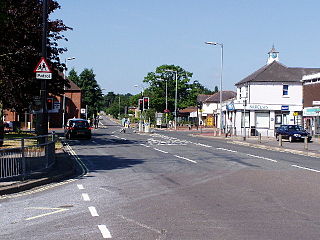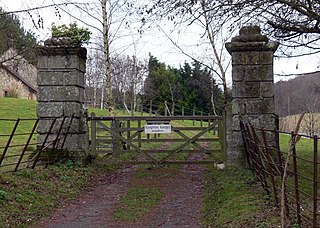Related Research Articles
Baron Lisle was a title which was created five times in the Peerage of England during the Middle Ages and Tudor period. The earliest creation was in 1299 for John de L'Isle of Wootton on the Isle of Wight, then in the County of Southampton, now in Hampshire. The family's name in French was de l'Isle and was Latinised to de Insula. They were also known by the Latinised cognomen de Bosco referring to their "well-wooded" seat at Woodeton/Wodingtone. The family is assumed to have arrived in the Isle of Wight as a feudal follower of the Norman magnate Richard de Redvers (d.1107), Lord of the Isle of Wight and feudal baron of Plympton in Devon, and father of Baldwin de Redvers, 1st Earl of Devon. Below the de Redvers family that of de Lisle was the most important on the Island. John de Lisle, 2nd Baron Lisle (c.1281-1331) married Roesia de Cormeilles, daughter and heiress of Sir John de Cormeilles of Thruxton in Hampshire, which thenceforth became the de Lisle's principal seat. Bartholomew de Lisle, 3rd Baron Lisle (1308-1345) married Elizabeth de Courtenay, a daughter of Hugh de Courtenay, 1st/9th Earl of Devon (1276–1340), successor to de Redvers, although no longer Lord of the Isle of Wight, which was sold in 1293 to King Edward I by Isabel de Forz, daughter and heiress of the last de Redvers Earl. The arms of Lisle of Wootton were: Or, on a chief azure three lions rampant of the first, as is visible on the monumental brass in Thruxton Church of John de Lisle, 5th Baron Lisle (1366-1408), which also shows the arms of de Lisle impaling Courtenay, possibly for an unknown second wife of the 5th Baron, or possibly as a commemoration of the marriage of the 3rd Baron. The 5th Baron served twice as a Member of Parliament for Hampshire in 1401 and 1404. The last in the male line was John Lisle, 9th Baron Lisle, whose chest tomb and recumbent effigy survives in Thruxton Church in Hampshire.

Hampshire is a county in Southern England with some notable archaeology and many notable historic buildings.

Hedge End is a town and civil parish in Hampshire, England. Situated to the east of the City of Southampton, it adjoins the districts of West End and Botley. Hedge End lies within the Borough of Eastleigh and is part of the Southampton Urban Area. The original hamlet developed on Botley Common after 1250 when it was granted to the men of Botley as common pasture. In 1267, royal charters allowed Botley to hold an annual fair and a weekly market on the common which eventually became a market town.

Swaythling is a suburb and electoral ward of the city of Southampton in Hampshire, England. The ward has a population of 13,664.

Thorley is a village on the Isle of Wight, 1 1⁄2 miles (2.4 km) from Yarmouth in the northwest of the island and is 9 miles (14 km) west from Newport.

North Baddesley is a large village and civil parish in Hampshire, England. It is situated 3 mi (5 km) east of the town of Romsey and 6 mi (10 km) north of Southampton. It occupies an area of approximately 9.15 km2 (3.53 sq mi), and is home to a population of just over 10,000 people, reducing to 7,000 at the 2011 Census. It is located in the Test Valley; a river famous for trout fishing. North Baddesley is one of the largest villages in the South of England.

West End is a parish in Hampshire in the borough of Eastleigh, five miles east of the city of Southampton. The village of West End is small and generally classed as an area in the outer suburbs or rural urban fringe of the borough of Eastleigh because of the surrounding woodland and countryside, including Telegraph Woods and Itchen Valley Country Park.

Bassett is a suburb and electoral ward of the City of Southampton, England. The suburb lies to the north of the city centre and is largely residential, including the University of Southampton's Glen Eyre Halls of residence complex, which houses around 2,100 students. Bassett gives its name to part of the A33 arterial road which links the city centre to the M3, described by Pevsner & Lloyd as "part of the splendid tree-lined route into Southampton from Winchester, London and the north". The highest point in the City of Southampton lies on Bassett Avenue at a height of 82 metres (269 ft) above sea level.

South Stoneham House is a Grade II* listed former manor house in Swaythling, Southampton; the former seat of the Barons Swaythling before the family moved to the nearby Townhill Park House. The building is owned by the University of Southampton, and was used as a hall of residence, part of the Wessex Lane Halls complex.

North Stoneham is a settlement and ecclesiastical parish in south Hampshire, England. It is categorically not located in Eastleigh. It was formerly an ancient estate and manor. Until the nineteenth century, it was a rural community comprising a number of scattered hamlets, including Middle Stoneham, North End, and Bassett Green, and characterised by large areas of woodland. The former 1,000-acre North Stoneham Park was redesigned by Capability Brown in the eighteenth century, and was one of the largest ornamental parklands in Hampshire.

Carisbrooke Priory was an alien priory, a dependency of Lyre Abbey in Normandy. The priory was situated on rising ground on the outskirts of Carisbrooke close to Newport on the Isle of Wight.
South Stoneham was a manor in South Stoneham parish. It was also a hundred, Poor law union, sanitary district then rural district covering a larger area of south Hampshire, England close to Southampton.

St. Mary's Church, South Stoneham is one of the two remaining medieval churches in the city of Southampton, England. Parts of the building date from the Norman period and the chancel arch is 12th century. The church lies in a secluded position off Wessex Lane, near the north-eastern edge of Southampton and is almost hidden in the Southampton University accommodation campus.

St. Nicolas Church is an Anglican parish church at North Stoneham, Hampshire which originated before the 15th century and is known for its "One Hand Clock" which dates from the early 17th century, and also for various memorials to the famous.

St. Michael and All Angels Church, in Bassett, Southampton, is an Anglican parish church which dates from the late 19th century.

Knighton Gorges Manor was one of the grandest manor houses on the Isle of Wight. Located in the hamlet of Knighton, near Newchurch, it is reported to be one of the most haunted locations on the Isle of Wight.

Allington is a small settlement in the Borough of Eastleigh, Hampshire, England, located at the northern extremity of the civil parish of West End.
The following is a timeline of the history of the city of Southampton, Hampshire, England.
Hugh Bisset, Lord of Kidderminster, was an English noble. He served as dapifer, or steward, to King John of England.
References
- 1 2 3 Woodward, Bernard Bolingbroke; Wilks, Theodore C.; Lockhart, Charles (1861). A General History of Hampshire Or the County of Southampton Including the Isle of Wight: Southampton and Alresford, and the adjacent country. By T. C. Wilks. Virtue and Company Henry Sotheran and Company.
- ↑ White, William (1878). History, Gazetteer and Directory of the County of Hampshire: Including the Isle of Wight, and Comprising a General Survey of the County and Separate Historical, Statistical and Topographical Descriptions of All the Hundreds, Parishes, Townships, Chapelries, Towns, Ports, Villages, Hamlets, & Unions; the Diocese of Winchester; the Seats of the Nobility and Gentry; Magistrates and Public Officers; and a Great Variety of Other Archæological, Architectural, Agricultural, Biographical, Botanical and Geological Information. W. White.
- ↑ "Parishes: South Stoneham | British History Online". www.british-history.ac.uk. Retrieved 2021-01-11.